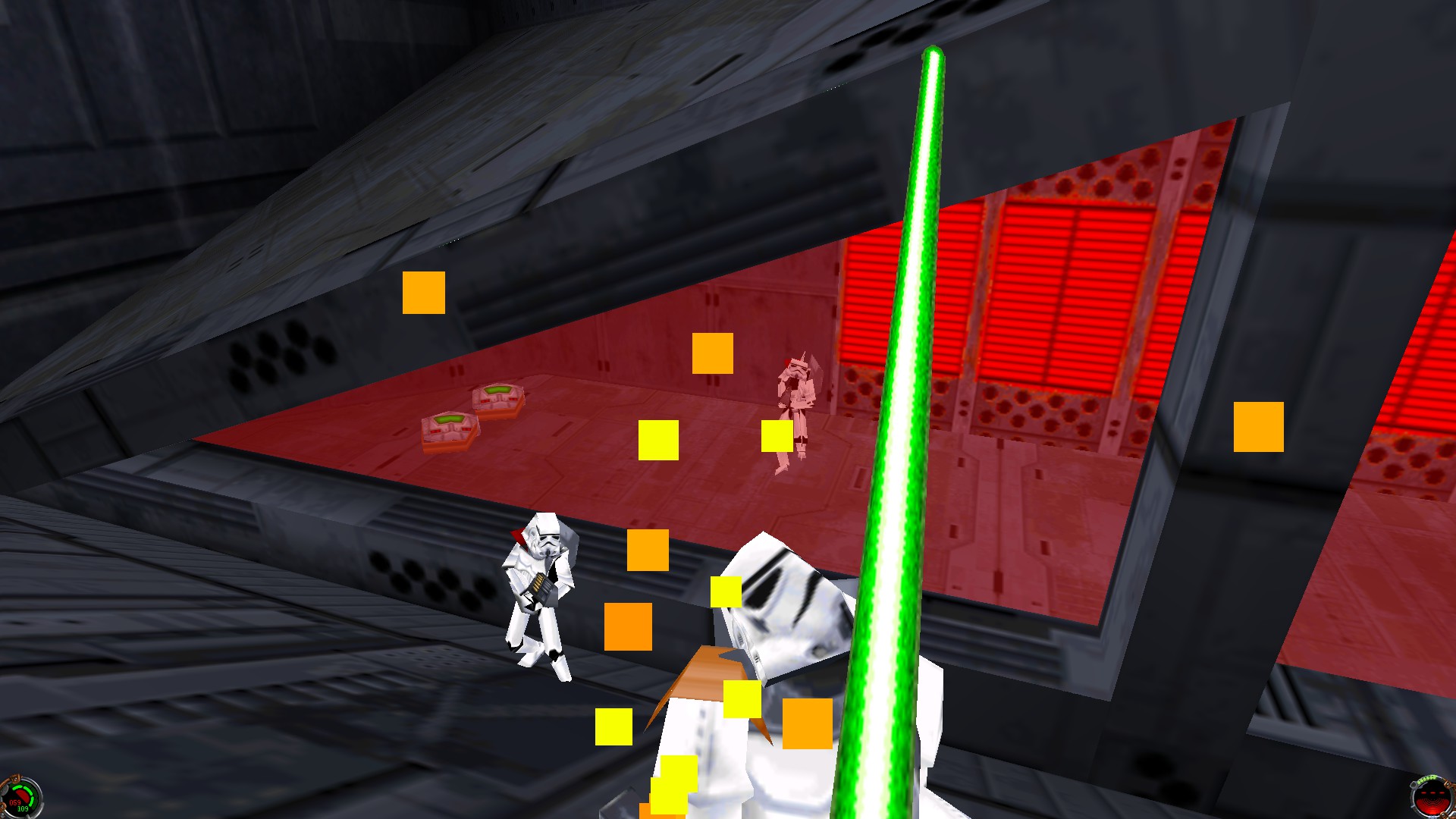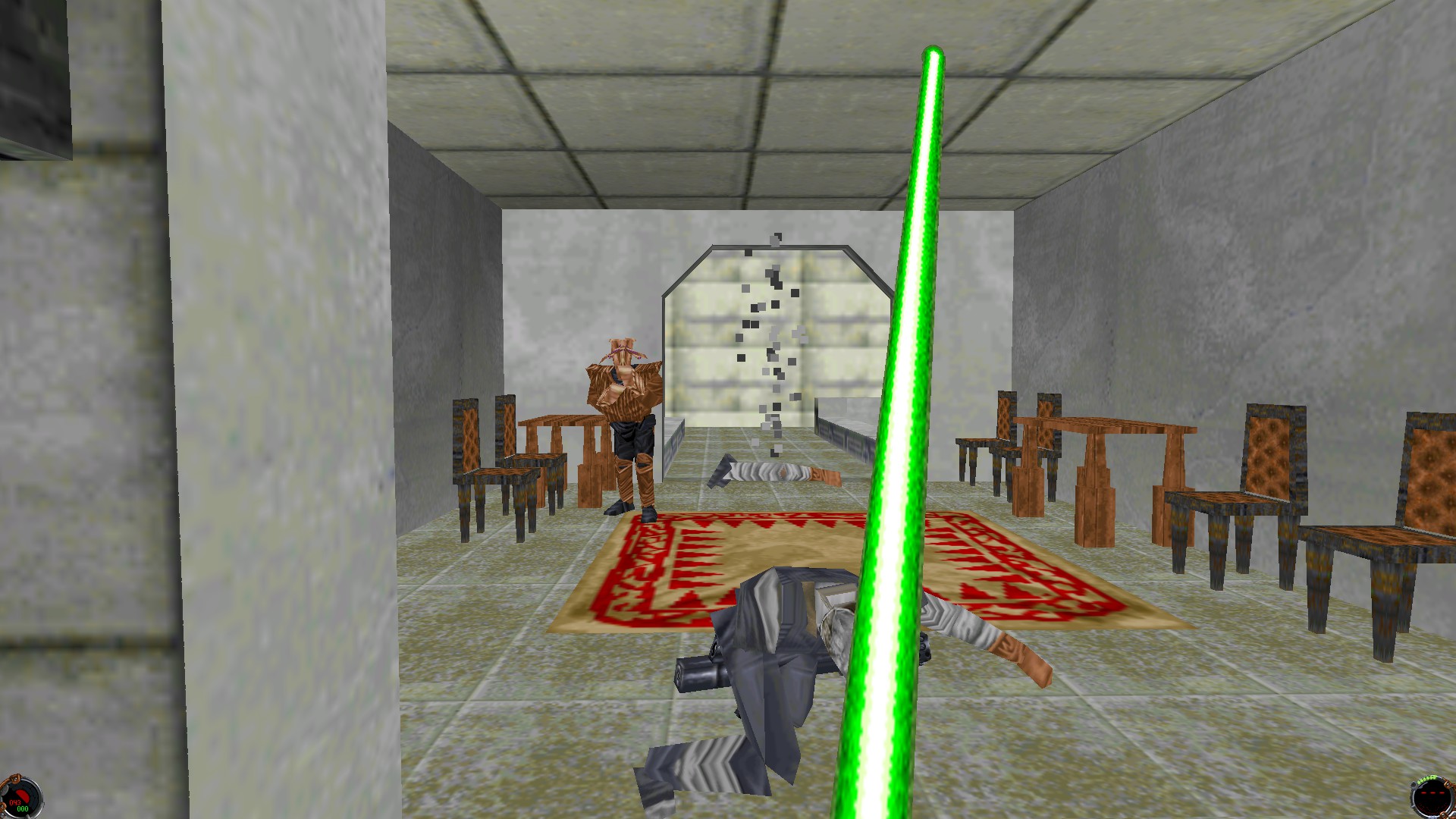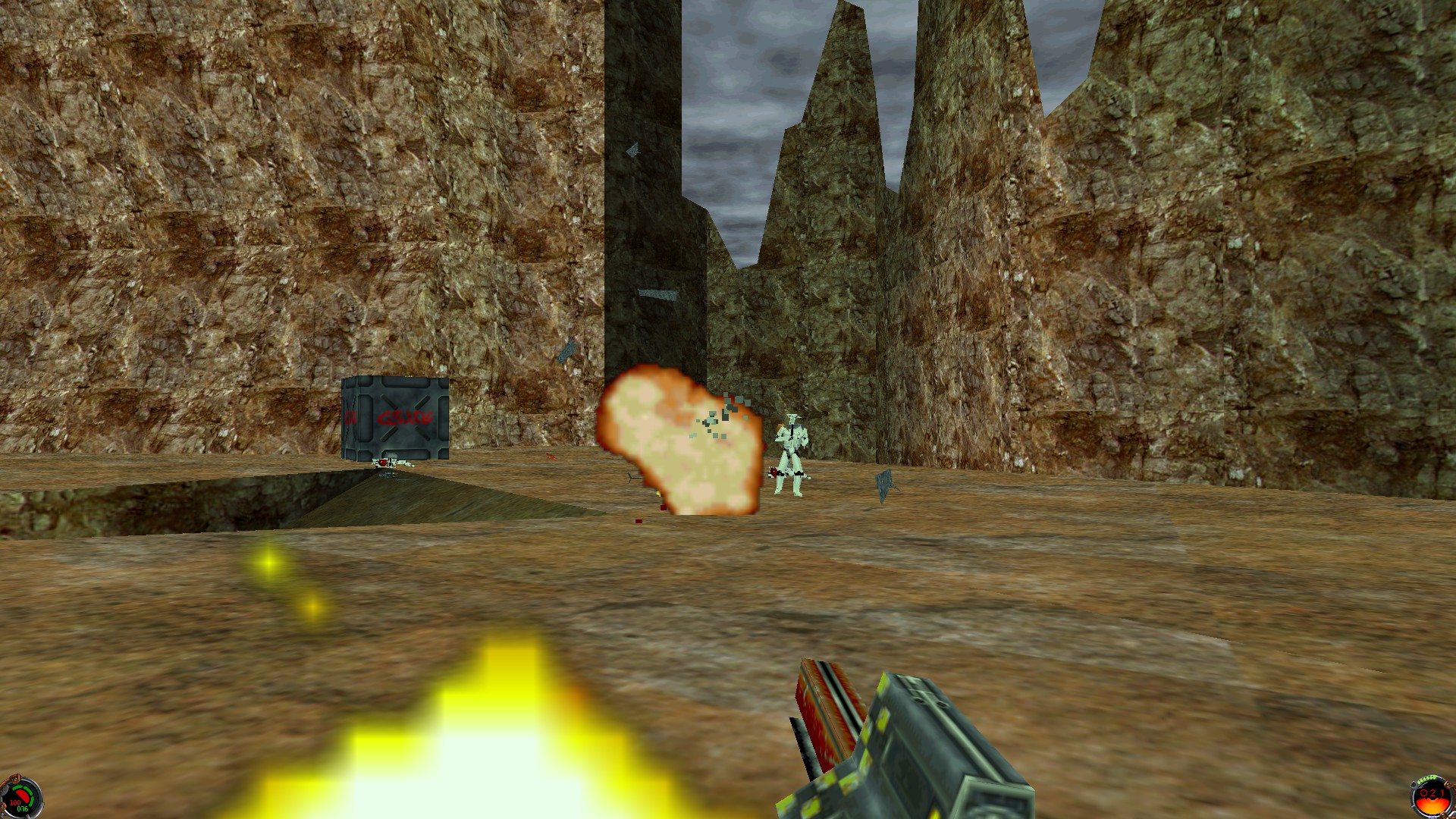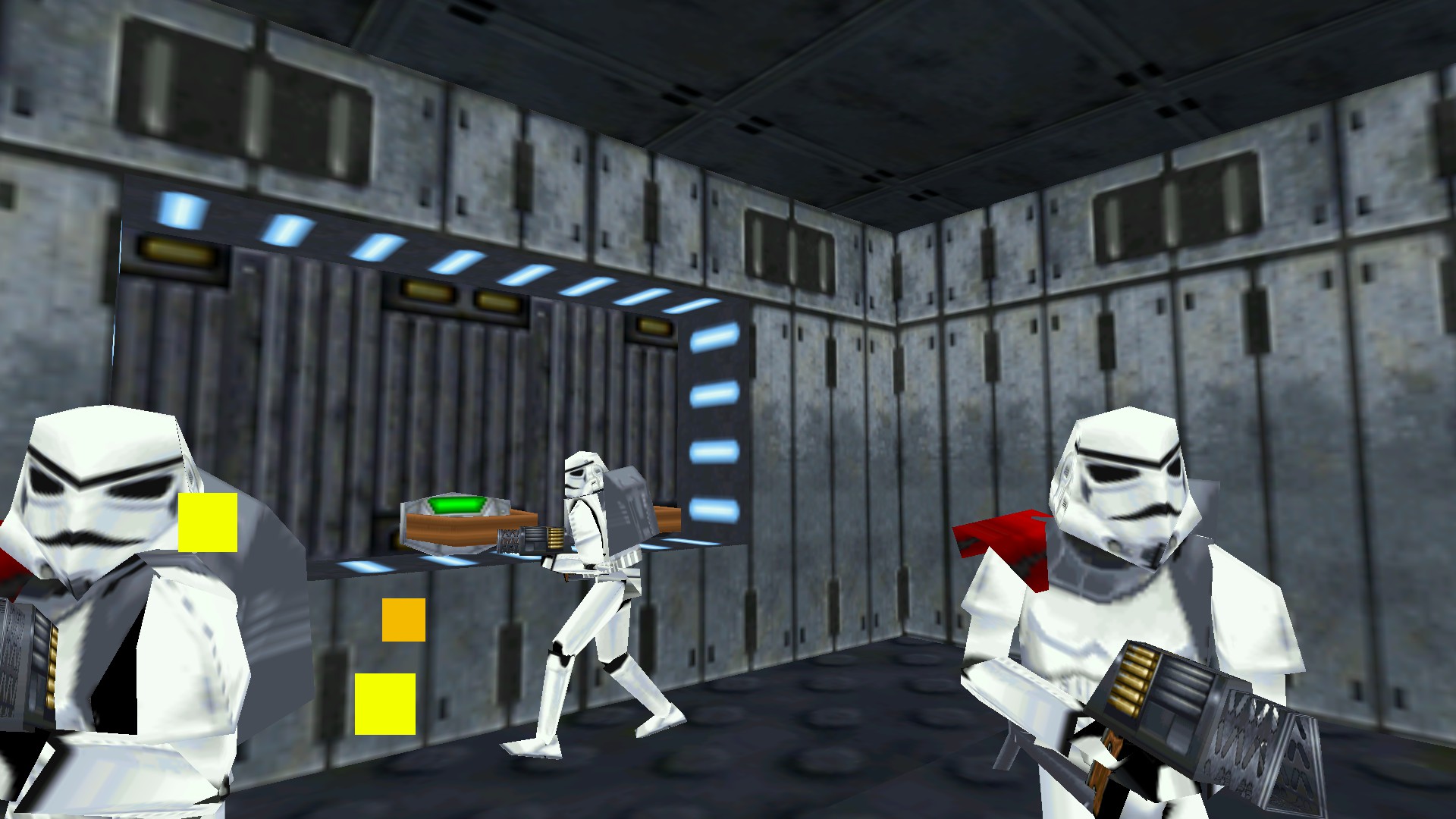
The best way to judge the quality of any Star Wars fiction is to ask, “What’s left if you take out the lightsabers?”. Remove those iconic laser swords from the original Star Wars and you’re left with basically the same propulsive adventure, only Darth Vader and Obi Wan settle their score with a fistfight instead. Take them out of the Phantom Menace and you’re left with two hours of dead-eyed chat about trade negotiations while Jar-Jar pricks about in the background like a nerf herder.
The same notion applies to Star Wars games. Take the lightsaber out of Jedi: Fallen Order and you’re left with a mediocre Uncharted clone. Take it out of Jedi Knight: Dark Forces 2, however, and you’re still left with a fantastic first-person shooter.
Admittedly, it’s an FPS which requires some adjustment played today, both in perception and getting the bloody thing running. More on that second point later, but for now let’s say that Dark Forces 2 does not like modern PCs at all.
On that first point, there’s no escaping it, today Dark Forces 2 has all the visual appeal of Jabba’s fat-rolls. Being an early true-3D shooter, all that extra power required to render proper polygons mean massively scaling down the level-of-detail on models and environments. Unlike Quake, which could tailor its art to suit its visual limitations, Jedi Knight is a Star Wars game, and therefore needs to mimic the Star Wars aesthetic. Hence you end up with angular stormtroopers, lightsabers you can sometimes see through, and a Kyle Katarn who looks like he’s cameoing in Minecraft.
Still, there’s a splendid shooter hiding behind that boxy exterior, one that reveals itself the moment you blast your first Gran (alien, not octogenarian) in a Nar Shaddaa dive, and he topples to the ground with bone-cracking force.
Hit reactions

Jedi Knight may look terrible, but it still feels amazing. And the way enemies react to being hit is just a part of it. Movement has a wonderful inertial quality. You start moving forward slowly and gradually accelerate. When you stop, you glide slightly before coming to a halt. Normal movement is relatively slow, but if you sprint Jedi Knight suddenly turns into Quake, with you able to zip around maps at blistering speed, and that’s without the Force Speed upgrade you get later in the game.
Weapons are equally satisfying to wield. My favourite is probably the Stormtrooper blaster, which has a satisfying recoil and perfect pew-pew laser sound. But all the weapons have their merits. The Imperial Repeater is a ferocious rapid-fire weapon, useful for clearing crowds of enemies. The Rail Detonator is your equivalent of a rocket launcher, complete with a devious alt fire where its rockets stick into surfaces and enemies for several seconds before exploding. The Concussion Rifle is so ludicrously powerful that it’s positively suicidal, wiping out everything when fired in a confined space, including yourself.
The biggest gaming news, reviews and hardware deals
Keep up to date with the most important stories and the best deals, as picked by the PC Gamer team.
Jedi Knight also spins an entertaining Star Wars yarn, commencing as a chase for a nefarious droid known as 8t88, who has information on the death of Kyle’s father, before slowly evolving into a race to the Valley of the Jedi, where Kyle must confront a group of Dark Jedi (as they are known-in game) led by a powerful Sith named Jerec. Most of the story is told through FMV cut-scenes, which are surprisingly enjoyable despite the bad CG and looking terribly grainy on a modern screen. They’re on the campy side, but I’d argue they feel more Star Wars in tone than any of the prequels, with a strong forward momentum and no tedious politics.
Story time

As with all good shooters, however, Jedi Knight does its best storytelling through its level design, which provides a huge variety in environments and ideas. In Nar Shaddaa, you battle with Gamorrean Guards and Rodian gangsters along perilously high gangways and across cargo-bay conveyor belts, using the crate lifts to ascend higher and higher into the city-moon’s endless skyline. Then you travel to Katarn’s home planet, searching his father’s dilapidated house while Tuskan Raiders ambush you in the darkness.
And those are just the starting levels. The real highlights of Jedi Knight come later. At Baron’s Hed, you navigate through the city’s sand-blasted streets, rescuing the civilians from 8t88’s thugs, before crawling through a ruined district to reveal the vast Imperial Tower of Into the Dark Palace. Here, a literal army of Stormtroopers supported by AT-STs stand between you and access to the palace. In the game’s second half, you’ll navigate the subterranean pipelines of an interstellar fuel station, fight across the surface of a spaceship as it flies in-atmosphere, and in one of the game’s most unique missions, try to escape another spaceship as it plummets to the ground.
What’s most striking about Jedi Knight’s level design is how Star- Wars-y it is, far more so than Fallen Order’s generic range of planets. Jedi Knight communicates the weird sense of scale many Star Wars locations have—the lofty hangar bays, the ridiculously oversized ventilation shafts, the many perilous drops that reflect the film’s locations such as Bespin and the Death Star. Jedi Knight’s ledges and walkways are still capable of putting your heart in your mouth, as you need to leap across a chasm that seems to vanish into shadowy infinity below you.
All of this is great regardless of whether or not you’re wielding a lightsaber. In that regard, Jedi Knight doesn’t have the same level of nuance as its sequel. But Jedi Knight’s ethos toward lightsabers and force powers is much more in the spirit of the original films. Jedi are rare and powerful, but not invincible. You can try to play the game exclusively with the saber if you want. But until you’ve really mastered your force powers, a blaster is a much more efficient way of taking out a large group.
Mod fixes

Unfortunately Jedi Knight has a highly unstable relationship with Windows 10, and in its default state will respond to switching on 3D acceleration by providing a black screen. Music and cutscenes also won’t play in the vanilla version
There are several ways to fix this, tutorials for which can be easily found online. There are also several different mods for improving the game’s visuals, such as DarthTrank’s 2009 FOV and Mipmap patches, which sharpen up distant textures and better adjust the game for 16:9 screen. There’s also the Jedi Knight Enhanced mod, which replaces a lot of the character and weapon models with those from Jedi Knight 2. Be warned though, some mods are incompatible with certain game fixes and vice-versa.
Even once you’ve got it running, you’ll need to accept the risk of the game crashing whenever you open the options menu, alongside a slightly scratchy element to the sound that I found strangely enjoyable, like playing an old vinyl record on a gramophone. That is, ultimately, what returning to Jedi Knight is like.
LucasArts’ most ambitious shooter is undeniably dated and is a bit of a faff to set-up. Once the record’s spinning, however, its experience has a texture that’s more than a match for modern tunes.
Rick has been fascinated by PC gaming since he was seven years old, when he used to sneak into his dad's home office for covert sessions of Doom. He grew up on a diet of similarly unsuitable games, with favourites including Quake, Thief, Half-Life and Deus Ex. Between 2013 and 2022, Rick was games editor of Custom PC magazine and associated website bit-tech.net. But he's always kept one foot in freelance games journalism, writing for publications like Edge, Eurogamer, the Guardian and, naturally, PC Gamer. While he'll play anything that can be controlled with a keyboard and mouse, he has a particular passion for first-person shooters and immersive sims.

